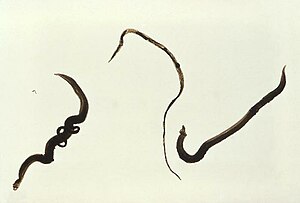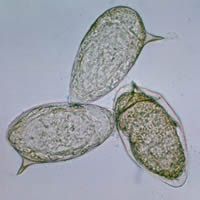Couple leeches
| Couple leeches | ||||||||||||
|---|---|---|---|---|---|---|---|---|---|---|---|---|

Schistosoma mansoni |
||||||||||||
| Systematics | ||||||||||||
|
||||||||||||
| Scientific name | ||||||||||||
| Schistosoma | ||||||||||||
| Wine Country , 1858 |
The fluke ( Schistosoma of ancient Greek σχιστος schistos cleaved 'and σῶμα soma , body') are a genus parasitic live flukes , which, especially in the tropics and subtropics occur. 83 species are known worldwide to date. They were originally named as Bilharzia after Theodor Bilharz , today only the name Schistosoma is common. Colloquially it is often referred to as the Nile worm , which does not do justice to its worldwide distribution.
features
The pair of leeches are characterized by some morphological and physiological peculiarities that distinguish them from all other flukes. For example, they are the only segregated representatives among the flukes. Males and females of the pair of leeches differ in size and shape ( sexual dimorphism ): After copulation, the longer female lives in the male's belly fold ( permanent popula ), whereby the front and rear ends protrude from this. The male's belly fold is also known as the gynecophorus canal .
distribution
The human pathogenic representatives of the pair of leeches can be found mainly in the tropical regions of the world. Schistosoma mansoni , an important pathogen of schistosomiasis , is represented everywhere on the African continent (including the Arabian Peninsula) where the important intermediate host Biomphalaria pfeifferi is represented. This ramshorn snail is mainly found in stagnant and slowly flowing waters. Schistosoma mansoni came to South America in the 19th century through the slave trade and can also be found in the eastern Caribbean. The important human pathogenic species Schistosoma haematobium still occurs on the African continent . In China, Japan and some other countries in East Asia and Southeast Asia, Schistosoma japonicum can be found as a human pathogenic representative.
In Europe and North America only a few genera are represented that parasitize on ducks. These representatives have indeed no medical relevance for humans, however, the second free-swimming larval stage, the cercaria, in affected lakes penetrate the skin of humans, where it dies and unpleasant itching triggers ( bathing dermatitis or Cercariendermatitis).
Life cycle
Pair leeches parasitize mammals, birds and crocodiles ( Griphobilharzia ) in the vascular system. The eggs that got into the water with the urine or stool of the definitive host contain an eyelash larva ( Miracidium ), which hatches and actively penetrates the first intermediate host (usually a ramshorn snail ). There it develops into the so-called mother sporocyst , which in turn forms daughter sporocysts , which migrate into the midgut gland of the snail. There the daughter sporocysts produce the characteristic fork-tailed cercaria . The latter leave the snail with its excretions and are now free in the water again.
The cercariae have to find a suitable final host in the water. When it comes into contact with the ultimate host, the cercaria penetrates the bloodstream through the skin, throwing off the forked tail. With a strong increase in length and restructuring of the tegument , the larva changes into a young but not yet sexually mature worm, which is known as the Schistosomulum. The schistosomula initially reside in the lungs and migrate to the portal vein to mate , where mating takes place when a female is accepted into the male's belly fold. This copula lasts a lifetime, which is what gave the pair of leeches their name.
The sexually mature animals (adults) settle in the venous system of their ultimate hosts, with the settlement site being determined for each species (usually mesenteric veins or urinary bladder veins ).
The adult pair of leeches feed on components of the blood in the ultimate host, including red blood cells and blood serum. The adult animals are harmless to the ultimate host, while the eggs can cause serious diseases (see below). The female of the pair of leeches releases the fertilized eggs into the host's bloodstream .
Due to inflammatory reactions in the veins in which the adult pair of leeches live, the vessels become permeable and the eggs reach the intestines or the urinary bladder. However, this only applies to about 50% of the eggs. The remaining eggs are drifted with the bloodstream and reach various organs of the body. In the affected organ tissues (especially the kidneys , liver , intestines and brain ), the reaction of the immune system to substances released by the embryo developing in the egg can lead to symptoms that lead to schistosomiasis , which is dangerous for the host organism or schistosomiasis .
Today science also assumes that the infection by the worm can also lead to bladder cancer. In July 2009, after four years of work, the 11,800 genes of the schistosomiasis pathogen were deciphered and partly analyzed.
species
Some species are listed below with the associated host snail genus or species.
- Schistosoma mansoni
-
Schistosoma haematobium
- Bulinus truncatus
- Bulinus globosa ( Bulinus globosus = Physopsis globosa - from: Dönges , Parasitologie, 1988) (?)
- Physopsis africana
- Planorbarius
- Schistosoma intercalatum (Central Africa)
- Schistosoma japonicum
- Schistosoma mekongi (China and Southeast Asia)
- Schisostoma bovis
In 2012, four more species were added to this genus, which were previously listed in the genus Orientobilharzia . Orientobilharzia can only be distinguished from Schisostoma morphologically by the number of testes. A review of the morphological and molecular data had shown that this difference is too small to warrant a division into different genera. The four species concerned are
- Schistosoma bomfordi
- Schistosoma datta
- Schistosoma harinasutai
- Schistosoma turkestanicum
hybrid
Various hybrids have been observed.
The hybrid S. haematobium-S.guineenis was observed in Cameroon in 1996 .
In 2003 a hybrid S. mansoni-S. rodhaini found in snails in western Kenya .
In 2009 S. haematobium – Schistosoma bovis hybrids were described in children in northern Senegal . Senegal's river basin has changed a lot since the 1980s after the Diama Dam in Senegal and the Manantali Dam in Mali . The salt water of the ocean can no longer penetrate the river basin, which enables new forms of agriculture there. Human migration, increasing livestock numbers, and places where humans and cattle pollute the water have enabled hybridization between different Schistosoma species. The same hybrid was identified in 2015 in a Schistosoma outbreak in Corsica that began on the U Cavu River .
See also
- Parasites of humans
- Praziquantel , an active ingredient against schistosomes (pair of leeches)
Web links
- Spiegel Online: Tropical parasite, worms in the blood as a travel souvenir
- The genetic makeup of the pair of leeches was deciphered in 2009
- Tagesspiegel: Weapons against the worm
Individual evidence
- ^ Marianne Abele-Horn: Antimicrobial Therapy. Decision support for the treatment and prophylaxis of infectious diseases. With the collaboration of Werner Heinz, Hartwig Klinker, Johann Schurz and August Stich, 2nd, revised and expanded edition. Peter Wiehl, Marburg 2009, ISBN 978-3-927219-14-4 , p. 293.
- ↑ Marianne Abele-Horn (2009), p. 293.
- ↑ Marianne Abele-Horn (2009), p. 293.
- ^ Adel AF Mahmoud: Schistosomiasis . Imperial College Press, 2001, ISBN 1-86094-146-X , pp. 20, 392 ( google.com [accessed July 31, 2016]).
- ↑ A. Mouahid, A. Théron: Schistosoma bovis: variability of cercarial production as related to the snail hosts: Bulinus truncatus, B. wright and Planorbarius metidjensis. In: Int J Parasitol. 17 (8), Dec 1987, pp. 1431-1434. PMID 3440697
- ↑ LA Tchuem-Tchuenté, VR Southgate, F. Njiokou, T. Njine, LE Kouemeni et al: The evolution of schistosomiasis at Loum, Cameroon: replacement of Schistosoma intercalatum by S. haematobium through introgressive hybridization. In: Trans R Soc Trop Med Hyg. 91, 1997, pp. 664-665. doi: 10.1016 / S0035-9203 (97) 90513-7
- ↑ JAT Morgan, RJ DeJong, NJS Lwambo, BN Mungai, GM Mkoji et al.: First report of a natural hybrid between Schistosoma mansoni and S. rodhaini. In: Journal of Parasitology. 89, 2003, pp. 416-418.
- ↑ T. Huyse, BL Webster, S. Geldof et al: Bidirectional introgressive hybridization between a cattle and human schistosome species. In: PLoS Pathog. 5, 2009, p. E1000571. doi: 10.1371 / journal.ppat.1000571
- ↑ Jérôme Boissier, Sébastien Grech-Angelini, Bonnie L Webster and others: Outbreak of urogenital schistosomiasis in Corsica (France): an epidemiological case study . In: The Lancet Infectious Diseases . tape 16 , no. 8 , 2016, p. 971-979 , doi : 10.1016 / S1473-3099 (16) 00175-4 .
- ↑ Kai Kupferschmidt: Killer worm threatens millions: The parasite could already have found a new strategy. In: SZ online.

